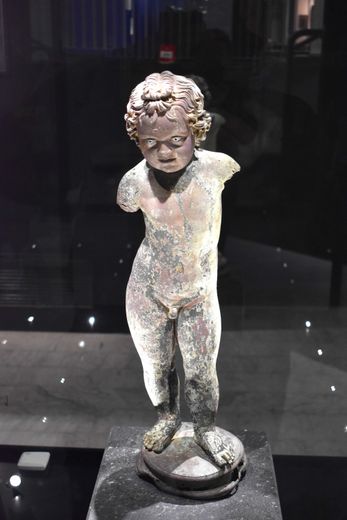That magical moment, 60 years ago, when the ephebe of Agde came out of the water, thanks to Jacky Fanjaud

It could be an evocation of Alexander the Great. Midi Libre – SYLVIE CAMBON
It now sits in the museum that bears its name, in Cap d'Agde, after having spent twenty years at the Louvre. The story of divers who dream of getting their hands on a treasure… And who find it. That timeless moment when a piece of the statue's shoulder protruded from the sand. Before the controversies over who made the discovery.
The history of underwater archaeology is very small… If Aimé Blanc had been a little lighter, the face of Agde might have changed… "The guy weighed 120 kg" and he had energetically stirred up mud with his flippers, recalled his diving buddy Jacky Fanjaud… Enough to catch a glimpse of a piece of oxidized copper sticking out of the sand.
We would later give a name to what he was about to caress with his hand: the ephebe of Agde. It was 60 years ago almost to the day, on September 13, 1964, in the Hérault River, at the foot of Agde Cathedral.
The most beautiful antique bronze ever found in France
Jacky Fanjaud was 31 years old. He is no longer here today: he died last year at almost 90 years old. September 13, 1964 had never left him. It was “the story of a life“… This suspended moment, eight meters from the surface, still alone facing what would turn out to be a discovery of great magnitude, the most beautiful ancient bronze ever found in France.
The diver had dug little by little, discovering the head after the shoulder, then the arm, the hand… Guaranteed emotion. Short of air, he had climbed the statue with a rope in the company of Denis Fonquerle, the leader of the underwater archaeological research and diving group of Agde (Graspa).
Aimé Blanc had come back down to retrieve the arm, torn off in the operation. From the Roman era, the statue of Hellenic inspiration that Jacky Fanjaud had taken for an Apollo when he came back up to the surface would represent the Macedonian king Alexander the Great.

The ephebe has just come out of the water, September 13, 1964. Azéma/Graspa/Museum of the Ephebe
The people of Agde gave him a nickname, given his height (1.33 metres) which was the opposite of the Great Alexander: the Pitchoun. However, one name stood out: the Ephebe. Denis Fonquerle had kept it at home for a while, before becoming afraid that it would be stolen. Direction Nancy to be restored, then the Louvre where it remained twenty years.
"My discovery escaped me"
If the State had wanted to recover the statue, it had opened the door a crack: André Malraux, then Minister of Culture, had conditioned this return on the construction of a museum worthy of the name in Agde. Which was done in 1984, thanks to the perseverance of the president of Graspa, Denis Fonquerle. To the point of obscuring Jacky Fanjaud. “My discovery escaped me, he declared in 2012.I take nothing away from Fonquerle's merit. I am very grateful to him for creating this research group, but he really took the spotlight […]. I am a nice guy. Probably too much."
In short, a very classic continuation of post-discovery battles, around the bust of Caesar in Arles or around the caves called Cosquer and Chauvet. Supporters of Denis Fonquerle (who died in 2005) agreed that he had “character” but that without him, the Ephebe would never have seen Agde again.

Caesarion, a “cousin” of the ephebe discovered in 2001. Sylvie Cambon
Since 2001, after a new discovery in Marseillan, two other statues of great beauty have completed the bronze department of the Musée de l’Ephebe, Caesarion and Eros.

Eros, representing the god of love, discovered in 2001 at the same time as Caesarion.
The Musée de l’Éphèbe is exceptionally free this weekend during the Journées du patrimoine. A temporary exhibition (until November 3), entitled RivÂges, also presents the evolution of the coastline over the past 20,000 years. I subscribe to read the rest




